AWS Storage Service - Why should we choose to store data on the Cloud?
I. On-Premises Storage versus AWS Cloud Storage
For many organizations, moving to the cloud starts with an assessment of their existing on-premises storage infrastructure. Organizations that take the time to identify where and how their data is stored, have a head start in moving their existing workloads to the AWS Cloud. As you explore the available AWS Storage services, you can compare the storage service offerings to your on-premises storage infrastructure.
In this lesson, you will learn to compare existing on-premises storage with AWS Storage service options and effectively assess your existing storage infrastructure. You will learn to identify patterns for diverse application and workload needs.
II. Why organizations move to the cloud
1. Increase organizational agility
On-premises storage agility challenges
Resources are required to make changes to on-premises storage infrastructure. Resources include time, personnel, data center space and infrastructure, and fixed and variable costs. Capacity planning, resource planning, and budgeting are required before you can implement changes. As a result, the time to implement changes can be delayed from weeks to months or even years.
Even after approval, it can take weeks or months to order, receive, and install new systems or additional capacity for existing ones. Many organizations offer provision storage capacity to deal with implementation and budgeting delays. The unused capacity consumes space and costly resources while waiting to be used.
On-premises storage infrastructure lacks the option to quickly reduce or change environments as your organization's needs change. After your storage is in place, it usually remains in place regardless of its use. Being able to re-allocate storage capacity from one storage silo or system to another silo or system is seldom possible. Most storage systems do not have the compatibility required for cross-system integration.
Storage agility in AWS
AWS Storage services provide solutions to address the on-premises storage agility challenges. When using AWS Storage services, you can quickly change existing storage services or implement new ones.
- AWS manages the required resources for you. You do not need to allocate time, implementation and management personnel, data center space and infrastructure, or use fixed and variable costs to change your storage infrastructure. You manage how you use the storage services that you provision.
- You have access to virtually unlimited storage capacity when you need it. You can add storage capacity on demand without over-provisioning capacity.
- You can reduce capacity or discontinue use of a storage service at any time. Your storage service use is not restrained by physical system limitations.
- With AWS services, you can move data between different storage silos or systems as needed. After copying your data to a different service, you can delete the source service, or delete the data from the service to save money.
2. Accelerate ability to innovate
- To innovate with on-premises storage systems, you need to purchase new systems or use unused capacity on existing systems. Purchasing new systems takes time and resources. Using existing systems can present challenges with available capacity or having the correct type of resource required.
- With on-premises storage systems, often the data is contained in separate storage systems that create silos that are disconnected from each other. The separation makes it difficult to access the systems to perform analytics or use machine learning across systems.
- With AWS Storage, you can start development on one service and experiment using different services to meet your workflow's requirements. You can increase or reduce capacity as needed for your development and testing environment. Using AWS Storage services provides you a flexible environment for innovation.
3. Strengthen security
On-premises storage and network infrastructure are often not uniformly secured from external or internal access. Security concerns include:
- Physical security access to storage systems
- Consistent encryption for data at rest and data in transit
- Appropriate user, group, and role access controls
- External network attacks or system hacking
Organizations can improve their security posture as they gain insights by removing data silos and improving encryption controls. With AWS, you inherit all of the controls, tools, best practices, and certifications designed for even the most security-conscious organizations.
Cloud providers secure the cloud infrastructure and separate the infrastructure from the customer applications. The benefit is you no longer need to be concerned about infrastructure security.
4. Reduce costs
With cloud storage, you do not have to purchase hardware, provision storage, or provide capital for "someday" scenarios. You can add or remove capacity on demand, quickly change performance and retention characteristics, and pay only for storage that you actually use. You can move less frequently accessed data automatically to lower-cost tiers in accordance with auditable rules. This flexibility drives economies of scale.
5. Operational expense versus capital investment
benefit of moving to the cloud is shifting expenses from fixed or variable costs to ongoing costs. Instead of paying for system and software expenses up front and then realizing the expenses over time, cloud services are charged as a monthly expense. This reduces budgeting and ordering fulfillment cycles and realizes the expenses when they occur.
III. Comparison of storage use: What you pay for
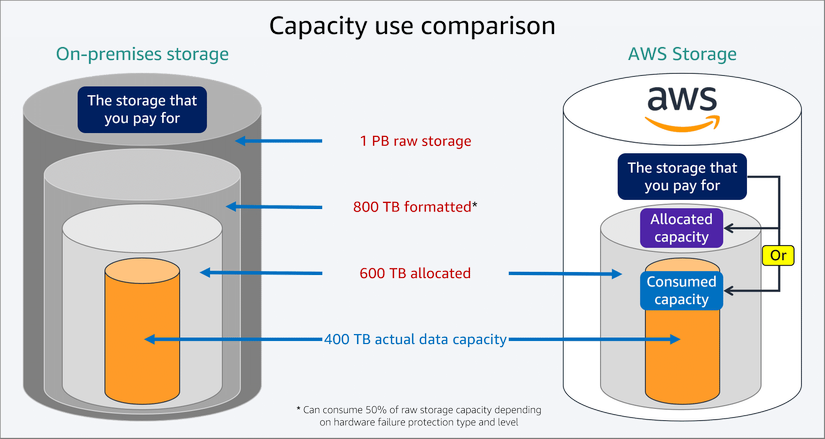
1. On-premises storage capacity
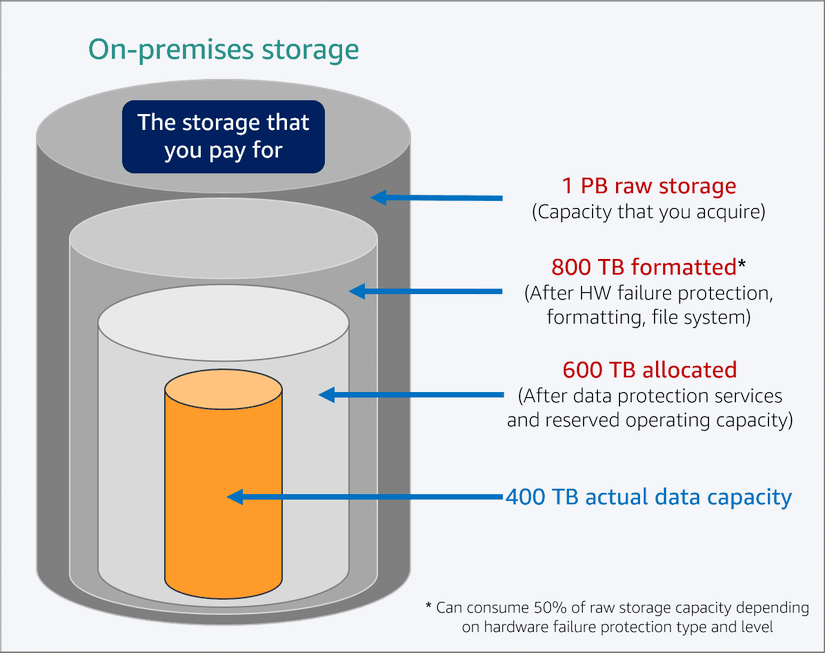 When you purchase on-premises storage, you work backwards from the capacity you need to store your data and provide for growth and performance overhead. You purchase the total raw capacity to meet your requirements and anticipated capacity growth. Because of certain variables, you are required to make forward-looking assumptions to estimate your requirements.
When you purchase on-premises storage, you work backwards from the capacity you need to store your data and provide for growth and performance overhead. You purchase the total raw capacity to meet your requirements and anticipated capacity growth. Because of certain variables, you are required to make forward-looking assumptions to estimate your requirements.
In the example, several broad assumptions are applied to perform the calculations for how much storage to acquire. The calculations applied in real life are different for every on-premises system. The calculations can vary significantly based on the manufacturer. The important takeaways from this example is to consider the aspects that reduce the usable capacity and that you pay for the raw capacity.
2. Capacity options for AWS Storage services
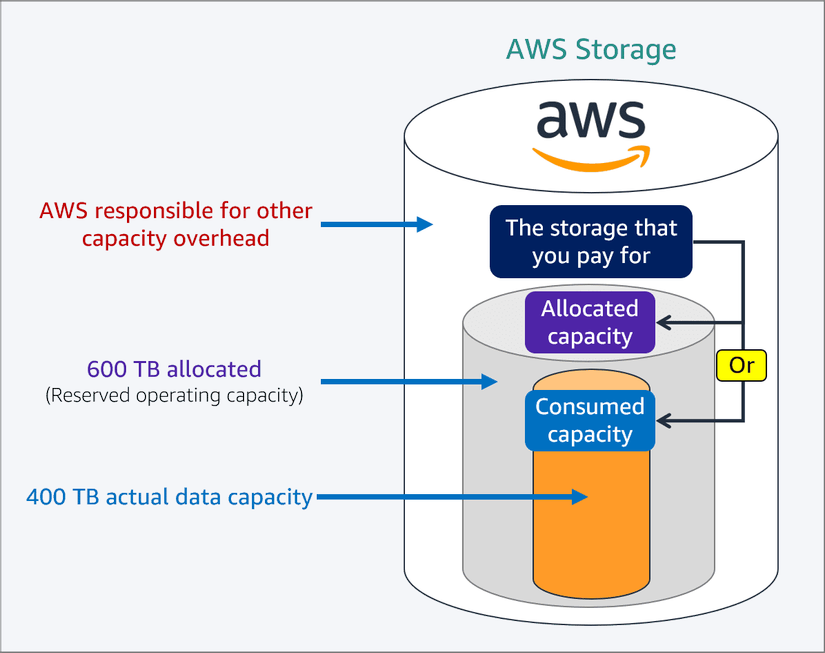 AWS uses two models for storage capacity: consumed storage and allocated capacity. The core storage service that you select determines the method used. Capacity is billed based on time that you use the capacity.
AWS uses two models for storage capacity: consumed storage and allocated capacity. The core storage service that you select determines the method used. Capacity is billed based on time that you use the capacity.
Billing increments are as small as per second of use. In addition to capacity billing, additional service charges might be incurred for service use. The different billing components are discussed later in this course.
Some services, such as Amazon Simple Storage Service (Amazon S3), are based on the amount of storage capacity that you consume. You pay only for the storage capacity that you use.
Other services, such as Amazon Elastic Block Store (Amazon EBS), are based on the amount of the capacity that you allocate. For example, when you create a block store of 20 GB, you are allocating 20 GB of capacity for use. With allocated capacity, you pay for the allocated amount of space and not the amount of data you have stored.
With Amazon Elastic File System (Amazon EFS), you have the option to use the default setting of consumed storage or provisioned storage. Select the option to meet your use case and application performance requirements.
IV. Primary storage types
Whether on premises or in a cloud environment, you have three primary types of storage: block, file, and object. Different storage hardware manufacturers and cloud service providers implement these storage types differently. However, the fundamentals for each storage type are basically the same, regardless of where the storage type is located, who manufactures the hardware, or who provides the service. The specific features and functionality differ based on how the manufacturer or service provider implements the storage.
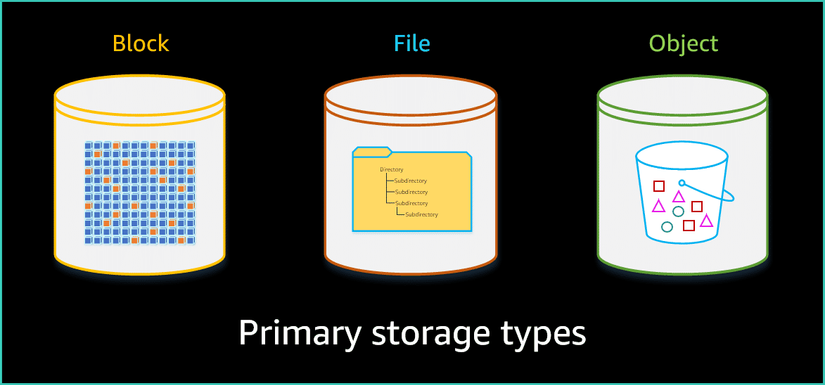
To get started, you should have a fundamental understanding of the primary storage types and the differences between them.
1. Block storage overview

Block storage is raw storage in which the hardware storage device or drive is a disk or volume that is formatted and attached to the compute system for use. The storage is formatted into predefined continuous segments on the storage device. These segments are called blocks. The blocks are the basic fixed storage units used to store data on the device.
Storage devices can be hard disk drives (HDDs), solid state drives (SSDs), or newer types of storage devices, such as Non-Volatile Memory Express (NVMe). In addition to individual storage devices, you can deploy block storage on storage area network (SAN) systems.
The storage device is used by the operating system or an application that has the capabilities to manage block storage directly. For cases in which the application manages the block storage, the application often shares management with an operating system.
2. File storage overview
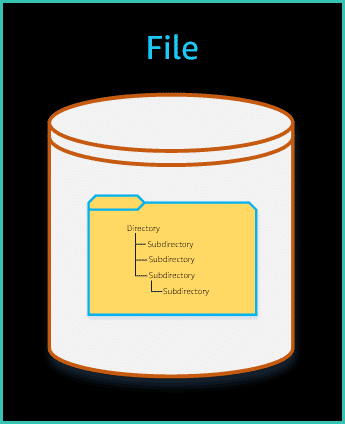
File storage is built on top of block storage, typically serving as a file share or file server. File storage is created using an operating system that formats and manages the reading and writing of data to the block storage devices. The name file storage comes from the primary use of storing data as files typically in a directory tree hierarchy.
The two most common storage protocols for file storage are Server Message Block (SMB) and Network File System (NFS). You can use the network protocols to communicate with remote computers and servers. You can also use server resources or share, open, and edit files.
The operating system manages the storage protocol and the operation of the file system. The file system can be Windows Server, Linux, or a specialized operating system used on network attached storage (NAS) devices or clustered NAS systems.
3. Object storage overview

Object storage is also built on top of block storage. Object storage is created using an operating system that formats and manages the reading and writing of data to the block storage devices. The name object storage comes from the primary use of storing the data within a binary object. Unlike file storage, object storage does not differentiate between types of data. The type of data or the file type becomes part of the data's metadata.
An object is made up of a larger set of blocks organized by using a predetermined size. For example, one object storage system uses binary object sizes of 128 megabytes (MB). Smaller files or data are stored at a binary level within the object. Larger data files are stored by spreading the data across multiple objects.
Object storage is recognized for its inherent availability of the file objects. Some systems support file versioning, file tracking, and file retention.
END
I will continue the series about storage on AWS in the next articles. Please look forward to it!
All rights reserved